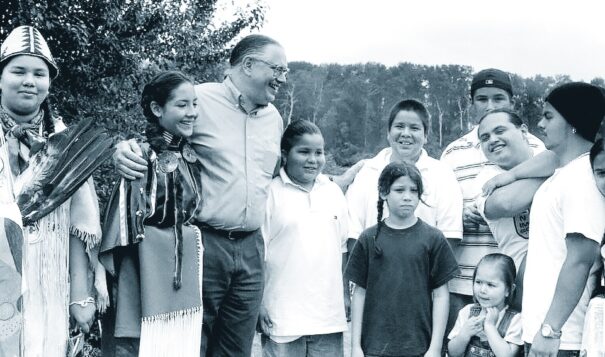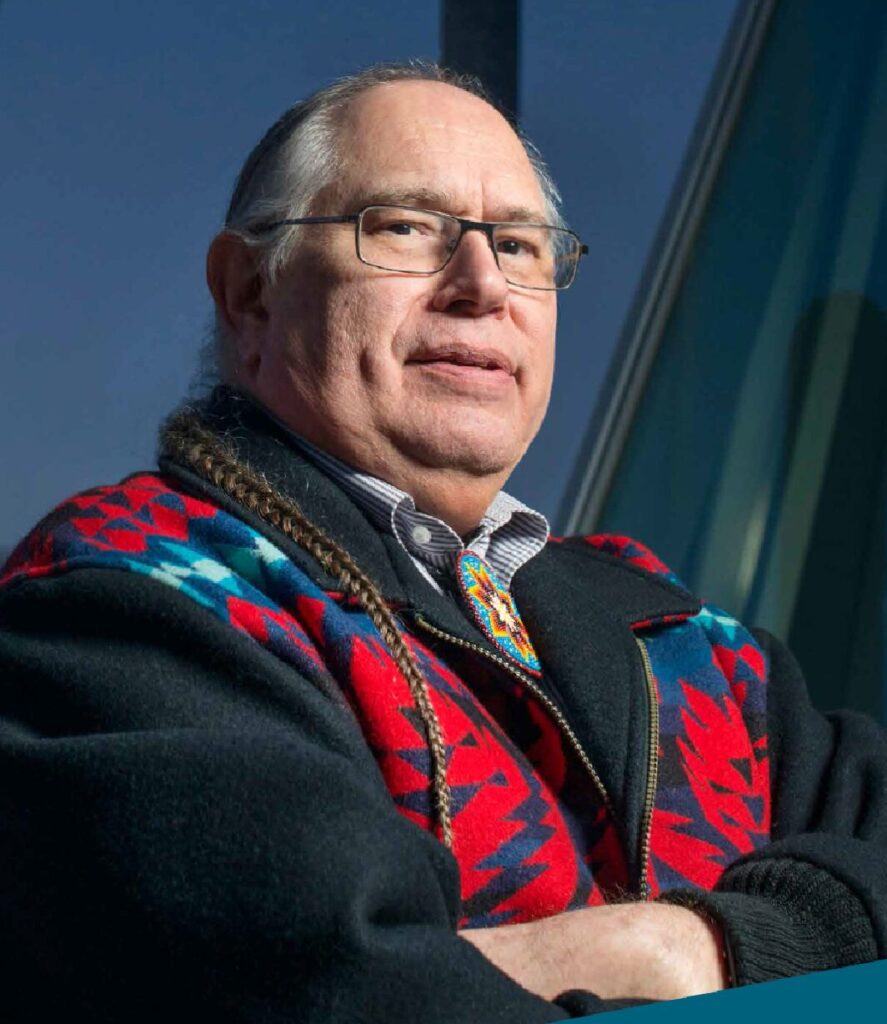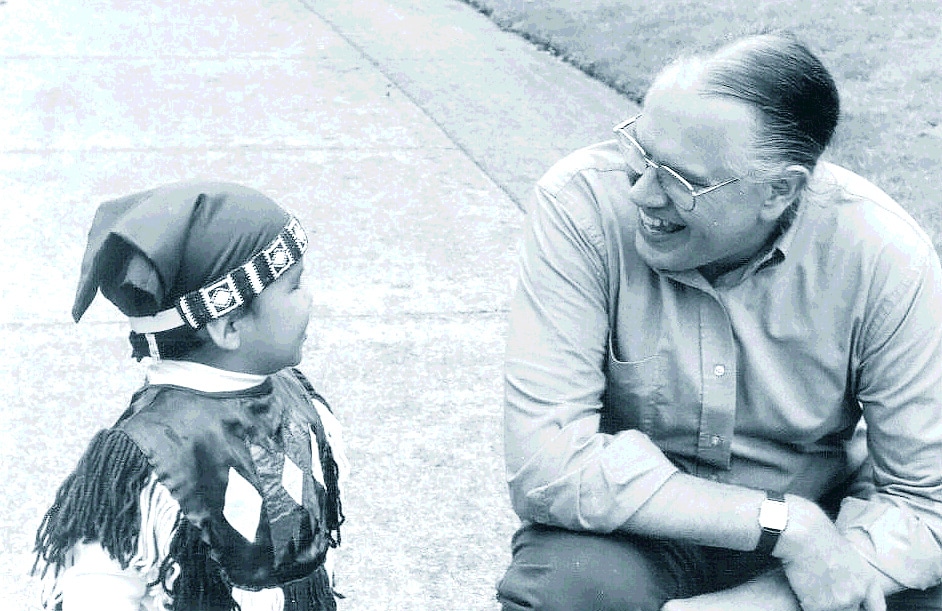News Based on facts, either observed and verified directly by the reporter, or reported and verified from knowledgeable sources.
Seneca Nation Elder Reflects on a 51-year Child Welfare Career
 Terry Cross with a group of children attending a NICWA-sponsored community gathering in 2001. (Photo provided by the National Indian Child Welfare Association.)
Terry Cross with a group of children attending a NICWA-sponsored community gathering in 2001. (Photo provided by the National Indian Child Welfare Association.)
Reporter Nancy Spears is President of the Indigenous Media Alliance.
This story is being co-published with The Imprint, a national nonprofit news outlet covering child welfare and youth justice.
Seneca Nation citizen Terry Cross is widely known as the founding executive director of the National Indian Child Welfare Association, launched in the early 1980s, and continues to serve as a senior adviser to the organization assisting tribes with preventing child abuse and neglect.
These days, Cross, 71, spends time taking long walks on the Nedonna Beach with his wife, Kristin, he said in a lengthy interview with The Imprint. But he admitted that he’s “not very good” at staying retired, and so his work with Indigenous children and families through the organization known as NICWA continues — in large part due to his optimism about the future.
“We have come a long way in the last 50 years,” Cross said of Indigenous-centered child welfare practices. “If things get as much better in the next 50 as they have in the last, we will be in awfully good shape.”
NICWA’s service to tribal governments, urban and reservation-based social service programs, and frontline staff who work with Native children and families focuses on foster care and adoption, children’s mental health, youth engagement and juvenile justice.
The association’s annual conference brings together some of the best minds on Native American child welfare topics, and its advocacy work provides key backing to state and federal policies that support the preservation of Indigenous children and families.
Cross, a member of the Bear Clan, said much of NICWA’s role in helping tribes fund and operate their own child welfare systems is hands-on and “doesn’t get a lot of fanfare.” But that is also its effectiveness.
“In every community, we meet with elders and youth to ask the question: ‘What does it mean for a child to be safe in your community?’ Because sovereignty around child welfare starts with a definition of safety for children, and then how you accomplish that safety is really an expression of sovereignty.”
As a younger man, Cross thought he would be an attorney. But when he got to Grove City College in Pennsylvania for his undergraduate degree, he fell in love with sociology, and later found his calling in social work, specifically the field of child welfare. Cross’s first job after receiving a bachelor’s degree from Grove City College in 1974 was working as a social worker for Mercer County in Pennsylvania.

Cross received his master’s degree in social work from Portland State University in Oregon in 1977 and returned to practice social work with his tribe, the Seneca Nation, on the lands now known as the Allegany Territory in New York. At the time, that level of academic achievement was rare for an Indigenous scholar. After a year of “profound learning” on the job, Cross returned to Oregon.
In 1983, with the support of 14 tribal child welfare directors, along with leadership from the Parry Center for Children and Portland State University, Cross launched what was then named the Northwest Indian Child Welfare Institute, serving communities in three states: Washington, Oregon and Idaho. The landmark Indian Child Welfare Act had been signed into law just five years prior — requiring social service agencies to take extra measures before separating young tribal members from their families and kin.
There was much work to be done ensuring the law was enforced and tribes could assert their rights. After four years, the Institute became the Northwest Indian Child Welfare Association, and finally, in 1993, a national organization. It now serves 1,222 individual members and 60 tribes and organizations in 37 states and six Canadian provinces.
NICWA’s journey hasn’t been without struggles. From 1988-89, the association operated with no funding. Cross went without a salary that year, picking up teaching jobs at Portland State University to pay his bills. The father of two traveled constantly for work in those early days.
But he speaks with pride of the lessons he passed on. One of his children, Amanda, now 48, followed in his footsteps, doing evaluation research for Indigenous communities. Her work helps communities know which services are most effective and where to invest scarce resources. His son, Matthew, 33, produces stop-motion animation, combining a mechanical engineering degree with artistic talent to create models for Netflix films and other productions.
When asked why he continues this work after more than half a century in the child welfare field, Cross’s answer was simple: “Because it’s who I am, and I have more to do.”
The following interview has been lightly edited for length and clarity.
When you were starting your career in Indigenous child welfare, how long did it take you to realize there was a need for an organization like NICWA?
It certainly was pretty early in the process because when I went home, there was no Indian Child Welfare Act, there were jurisdictional disputes. There was really no place for our kids to get service when there were difficulties in their families. The states and counties either didn’t serve our families or their solution was just removal. We didn’t have any infrastructure to try to handle those issues, so kids went without services.
Part of what got me into this was I was young, idealistic and wanted to change the world. I found I was trying to help kids who were experiencing things they should never have experienced, but I couldn’t get anybody to do anything about that because I didn’t have any authority myself. If I was ever going to be taken seriously, I knew I had to have more letters behind my name. And I knew I had to have a lot more experience and credibility.
You have 51 years of experience in the child welfare field, including 10 years of direct service. What could be improved for better compliance with the Indian Child Welfare Act, and to foster a broader understanding of tribal customs and traditional child-rearing practices?
In child welfare we exist in a changing world. We have so many more people educated to do this work, and one of the accomplishments of NICWA is we’ve brought more than $3 billion to Indian children and family services, which means a huge expansion in the number of people that can be employed in tribal programs.
There’s just been a tremendous shift in the way tribes exercise their jurisdiction, and we’ve helped bring about changes in state laws. But one of the most important things we’ve done as an organization is to really help define what it means to be Indigenous child welfare agencies, and the importance of incorporating our tribal teachings into the way we work with families.
Mainstream child welfare tends to make the trauma worse for kids, and I believe child welfare needs to be a healing service, helping families function in the ways our ancestors would tell us that families ought to operate.
The Indian Child Welfare Act, at the time of NICWA’s founding, was a relatively new federal law. What challenges did you face, and how did you overcome them?
A number of challenges were primarily trying to sustain the funding. During our first four years we developed a curriculum called Heritage and Helping, so we were selling a lot of curriculum and I was doing training on contract. And then, suddenly, we got a start-up grant, and then a federal grant, and we were off and running.
But the other major challenge was keeping up because of the demands, which were such that I was on the road constantly providing services in tribal communities, whether training or technical assistance, or going to DC to do advocacy. This work wasn’t just me — it was also board members, volunteers and staff. We had a lot of spiritual help on that. It was as if the spirit of NICWA was intended to be — all of us just had to keep up with it and show up, to take advantage of every opportunity to make the lives of Indian children and families better.
What continues to motivate you to do this work?
We are in a critical moment in time as we Indigenize the field of tribal child welfare, and there’s several aspects to that. Because the assaults of colonization aren’t going away anytime soon, we have to be strong in who we are as Native people and define our own programs — everything from assessment to treatment plans, how we define outcomes, how we measure those outcomes. All of that can be seen through an Indigenous lens.
So part of what keeps me in the field is I’m curious about all of those things. And the way you exercise your curiosity is by talking and writing about those things, and spending time with other people who are trying to do the same things you’re doing. I have always viewed it as taking the principles, teachings and values of our past generations and translating them into modern practice.
A central challenge tribes face is receiving adequate federal funding to run vital social programs like foster care systems. Where do you think efforts need to be made to secure more dollars available under Title IV-E and Title IV-B of the Social Security Act for tribes, and do you see headway being made?
Keeping in mind this is a 40-year perspective on funding issues: Yes, I see progress and sometimes it’s painfully slow. It took us 17 years to get tribes to even legally have access to IV-E funds, I think there’s like 20 tribes, a very small number are now running IV-E — it’s a very difficult program to operate, but not impossible.
There are changes in the way IV-E is administered, and each time we make inroads with making it more accessible to tribes. The most important recent change has been access to changes in IV-E allowing tribes to prevent children from being placed out of home, and that’s a tremendous boost. So while we have worked very hard to not only gain the policy changes needed for tribes to have access, we’ve also advocated for tribes to build the infrastructure, the capacity to make the decisions about it. We think eventually you will see some changes that are larger.

As the author of the “Positive Indian Parenting” curriculum published by NICWA, and co-author of “Towards a Culturally Competent System of Care,” published by Georgetown University, what can you tell me about the state of efforts within tribes to make family wellness a more culturally based and effective practice?
We found there’s a lot more out there than anybody realized, and we had a lot more memory about how to raise children in a good way because every tribe has spiritual teachings about child development, about how children should be treated.
For those who’ve gone to boarding school, or those who’ve been reared in foster care, so many of our people were deprived of the opportunity to learn really positive ways of raising children. We need to be able to restore that and to give them the opportunity, because they’ve been told by the mainstream child welfare system that there’s something wrong with them.
Our approach is to say, ‘Here’s the teachings of our ancestors, many of you have missed this, and you have a right to learn it as an Indigenous person.’ Then you decide how you want your children raised. But the essence of those tribal teachings remains the same, because they have been handed down from time immemorial.
Is there anything else you would like to share with our national audience?
We never take a policy position that we have not vetted with tribal leaders. We also learned over the years that when we go to Congress, if we take a tribal leader with us we’ll be listened to differently. If we take a family or youth with lived experience, it will influence the way they think about our ask. It takes the advocate like myself or one of our staff, it takes the tribal leader who’s willing to be a spokesperson carrying the legitimacy of tribal sovereignty into the advocacy arena, and it takes young people or families with lived experience.
When I say NICWA has had these accomplishments, it’s because we’ve had so many people stand with us. The things I’ve been able to do in my career are mostly about showing up, about people by my side — people who I can then push forward like the elders did to me when I was young, with our ancestors on my shoulder, guiding me on what needs to be done. It’s been a privilege to be empowered as the agent who moved things along.
